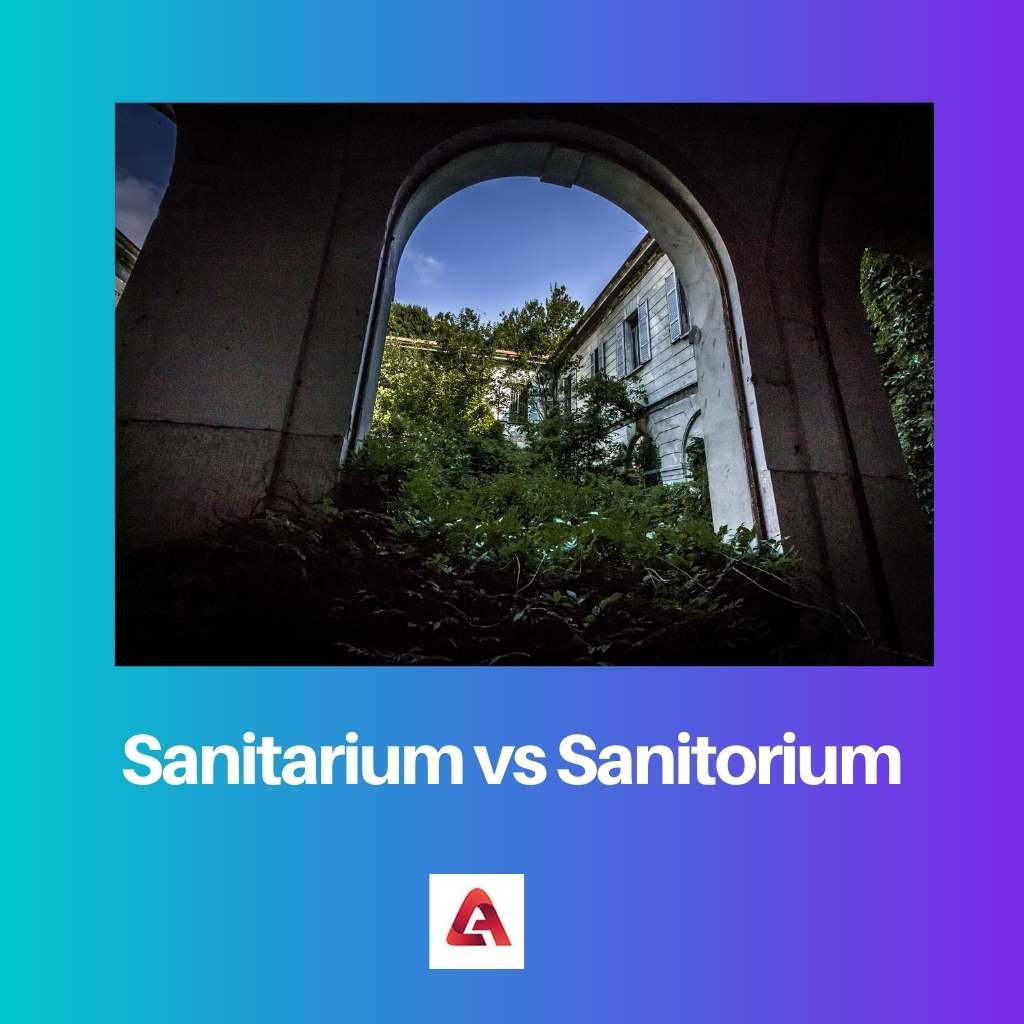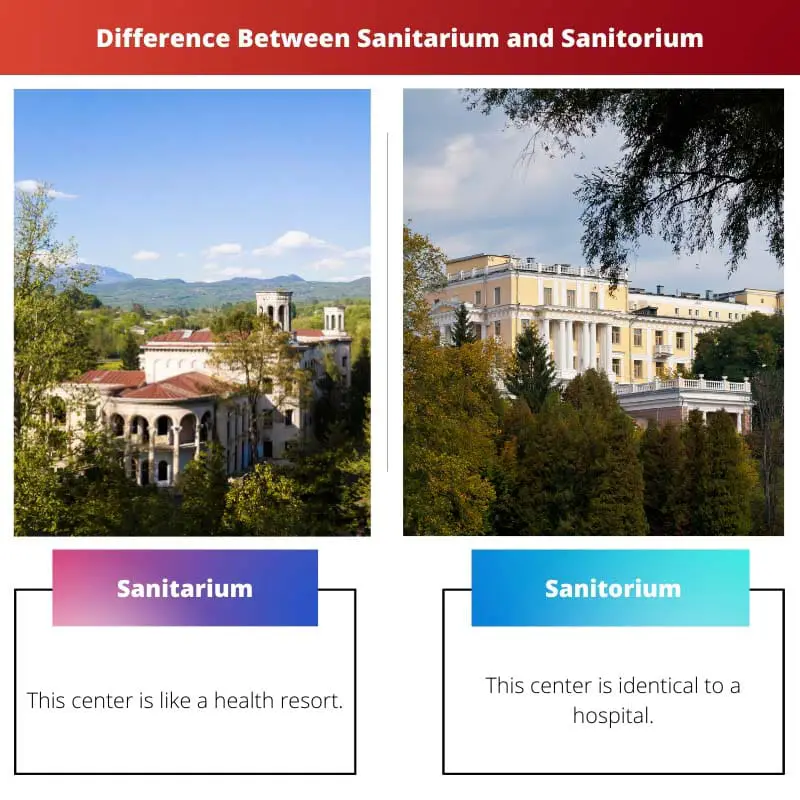People with severe ailments used to have few treatment options. Visiting the sanitarium or sanatorium was one of the options for treatment. These two words refer to very similar medical facilities.
A sanitorium or sanatorium is a medical centre that is specifically designed for patients with long-term ailments. The distinction between the two is minor. Often the two terms may be coined interchangeably.
Key Takeaways
- Sanitariums are health facilities focused on wellness and recovery, while sanitoriums are specialized facilities for treating chronic illnesses.
- Sanitariums emphasize holistic care and natural therapies, whereas sanitoriums may provide more medical interventions.
- Sanitariums were historically associated with Seventh-Day Adventists, while sanitoriums were not linked to a specific religious group.
Sanitarium vs Sanitorium
A sanitarium is a medical centre for the treatment of ailments and diseases for patients. It resembles a health resort that is built near springs to offer maximum health benefits. A sanatorium is a medical centre for the treatment of illnesses like tuberculosis. It is built in open spaces on a high ground or near the sea.

Sanitariums have been there for a great many years, and the word “sanitarium” comes from the Latin word “Sanitas,” which means “health” and refers to the benefits of visiting one. Sanitariums are medical centres in the traditional sense.
A sanitarium provided comfortable living quarters and a plentiful supply of nutritious foods. Sanatoriums were frequently constructed near mineral springs or other natural water sources supposed to offer health advantages.
A sanitorium is a centre dedicated to promoting health via proper nutrition, fitness, and relaxation. The name change is intended to emphasize the sanatorium’s focus on healing the sick, most commonly tuberculosis sufferers.
Sanatoriums were constructed in distant locations with plenty of open space, sometimes on high ground with a pleasant outlook or near the sea. In the treatment of tuberculosis patients, daylight and clean air were deemed essential.
Comparison Table
| Parameters of Comparison | Sanitarium | Sanitorium |
|---|---|---|
| Meaning | This centre is like a health resort. | This centre is identical to a hospital. |
| Built near | Near mineral springs or other natural water sources which are supposed to provide health advantages. | In distant locations with plenty of open space, sometimes on high ground with a pleasant outlook or near the sea. |
| Original words | The Latin word “Sanitas” means “health. | The well-known Latin word. This is “Sano”. It means “to heal. |
| People | A person visiting this centre may or may not be ill with a sickness. | These were built for people suffering from several illnesses, mainly TB. |
| Ensures health by | Providing comfortable living quarters and a plentiful supply of nutritious foods. | Promoting health via proper nutrition, exercise, and relaxation. |
What is Sanitarium?
A sanatarium (also sanitorium, sanitarium) is a medical centre for people who have been sick for a long time, with TB.
Sanatoria were established because, before antibiotics, a routine of relaxation and excellent nourishment provided the best opportunity for a patient’s immune system to “wall off” areas of a pulmonary bacterial infection or pulmonary tuberculosis (TB) infection.
Patients were given sufficient high-altitude clean air and proper nutrition. From the late 19th century onwards, TB sanatoria became commonplace across Europe.
Sanitariums were frequently constructed near mineral springs or other natural water sources supposed to provide health advantages.
Health resorts are also referred to as “sanitariums. These health resorts fulfil the same objective. However, they are no longer limited to tuberculosis treatment. Sanitariums are medical centres in the traditional sense.
A person at a sanitarium may be there for any number of reasons, but they may or may not be ill with a sickness.
These centres were designed to isolate infected persons from the rest of society and provide them with adequate nutrition, clean air, and relaxation.
A medical centre is also referred to as a “sanitarium.” Wellness resorts are also referred to as “sanitariums.” These wellness resorts serve the same objective. However, they are no longer limited to tuberculosis treatment.

What is Sanitorium?
A need was felt to make a clear difference between the wellness resorts that folks were acquainted with and the new tuberculosis care hospitals: So they resolved to use a new word which, instead of being obtained from the Latin noun Sanitas, meaning health, would emphasizing the new tuberculosis treatment hospitals.
As a result, they coined the term sanatorium from the Latin verb root Sano, which means “to heal.”
Sanatoriums started to close after the development of streptomycin. It was the first true treatment for tuberculosis in 1943. Many were converted into general hospitals, as was the case with the Paimio Sanatorium.
Tuberculosis was no longer a serious public health threat by the 1950s. This was when most sanatoriums had come to the end of their useful lifetimes. The majority of sanatoriums have been dismantled in recent years.
A sanatorium is a centre dedicated to promoting health via proper nutrition, fitness, and relaxation. The name change is intended to emphasize the sanatorium’s focus on healing the sick, most commonly tuberculosis sufferers.
Sanatoriums were constructed in distant locations with plenty of open space, sometimes on high ground with a pleasant outlook or near the sea. In the treatment of tuberculosis patients, daylight and clean air were deemed essential.

Main Differences Between Sanitarium and Sanitorium
- Sanitarium is like a health resort, while Sanitorium is identical to a hospital.
- Sanitariums were constructed near mineral springs or other natural water sources supposed to provide health advantages. Sanitoriums were constructed in distant locations with plenty of open space, sometimes on high ground with a pleasant outlook or near the sea.
- The word Sanitarium is derived from the very well-known Latin word “Sanitas.” This word means “health whereas, the word Sanitorium is derived from another well-known Latin word, “Sano.” This word means “to heal.
- A person visiting the Sanitarium may or may not be ill with sickness, but people Sanitoriums were built for people suffering from several illnesses, mainly TB.
- A Sanitarium ensures health by providing comfortable living quarters and a plentiful supply of nutritious foods. On the other hand, in a Sanitorium, health is ensured via proper nutrition, exercise, and relaxation.




